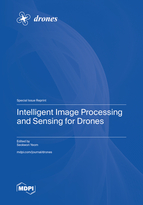Intelligent Image Processing and Sensing for Drones
A special issue of Drones (ISSN 2504-446X).
Deadline for manuscript submissions: closed (25 December 2023) | Viewed by 41608
Special Issue Editor
Interests: intelligent image processing; deep/machine learning; target tracking
Special Issues, Collections and Topics in MDPI journals
Special Issue Information
Dear Colleagues,
Recently, the use of drones for various purposes is increasing. Drones can be remotely controlled or programmed to capture scenes from a distance. This capture is cost-effective and does not require highly trained personnel. Drones are widely used in various fields such as video surveillance, wildlife and farm monitoring, industrial investigation, search and rescue, firefighting, and 3D visualization.
Multiple sensors can be mounted on a drone. In addition to conventional visual cameras, infrared thermal imaging and multispectral imaging are available for drones. LiDAR and SAR are active sensors that can be mounted on drones. These mobile aerial imaging sensors provide a new perspective on research and development for a variety of applications. However, more challenges are often posed than grounded cameras because of the unique sensing environments and limited resources of a drone. Certainly, information acquired by a drone is of tremendous value, thus intelligent analysis of them is necessary to make the best use of it.
This Special Issue focuses on a wide range of intelligent processing of images and sensor data acquired by drones. The objectives of intelligent processing range from the refinement of raw data to the symbolic representation and visualization of the real world. This can be achieved through image/signal processing or deep/machine learning algorithms. The latest technological developments will be shared through this Special Issue. Researchers and investigators are invited to contribute original research or review articles in this Special Issue.
Article / Review
Prof. Dr. Seokwon Yeom
Guest Editor
Manuscript Submission Information
Manuscripts should be submitted online at www.mdpi.com by registering and logging in to this website. Once you are registered, click here to go to the submission form. Manuscripts can be submitted until the deadline. All submissions that pass pre-check are peer-reviewed. Accepted papers will be published continuously in the journal (as soon as accepted) and will be listed together on the special issue website. Research articles, review articles as well as short communications are invited. For planned papers, a title and short abstract (about 100 words) can be sent to the Editorial Office for announcement on this website.
Submitted manuscripts should not have been published previously, nor be under consideration for publication elsewhere (except conference proceedings papers). All manuscripts are thoroughly refereed through a single-blind peer-review process. A guide for authors and other relevant information for submission of manuscripts is available on the Instructions for Authors page. Drones is an international peer-reviewed open access monthly journal published by MDPI.
Please visit the Instructions for Authors page before submitting a manuscript. The Article Processing Charge (APC) for publication in this open access journal is 2600 CHF (Swiss Francs). Submitted papers should be well formatted and use good English. Authors may use MDPI's English editing service prior to publication or during author revisions.
Keywords
- visible / infrared thermal / multispectral image analysis
- LiDAR / SAR with a drone
- video surveillance
- monitoring and inspection
- 3D imaging and visualization
- detection, recognition, and tracking
- segmentation and feature extraction
- image registration and fusion






